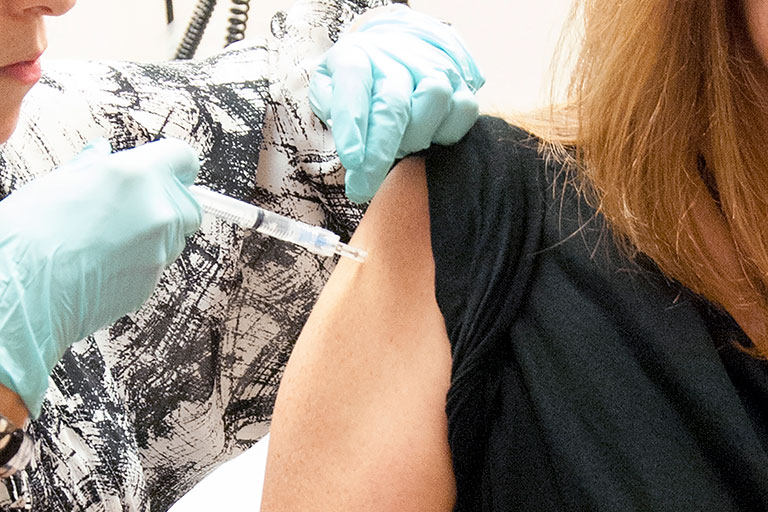November 2020
With over one million COVID-19 deaths worldwide, pharmaceutical companies are racing to develop vaccines to help bring an end to the ongoing pandemic. But once a vaccine is approved and hits the market, will people be willing to get it?
Katharine Head, of the IU School of Liberal Arts at IUPUI, and a team of researchers are identifying the best ways to educate the public about the safety and effectiveness of the vaccine, to help reach “herd immunity” safely. The team includes Lynne Sturm and Gregory Zimet of the IU School of Medicine, Jane Hartsock, also of the IU School of Liberal Arts at IUPUI, and Purdue University’s Monica Kasting.
“Having really focused, targeted communication about vaccination has never been more important,” said Head, an associate professor of communication studies and an expert in health communication. “While vaccination is a private, individual decision, it has public health ramifications, and public health experts agree that the launch of this vaccine will be the beginning of the end of the pandemic, something we can all get behind.”
To better inform messaging and interventions regarding the COVID-19 vaccine, Head and the team launched a national survey in May of more than 3,100 American adults. Participants answered questions about their perceptions of the virus, susceptibility, worries, and whether they thought it was a problem for their community. They were also asked about their intentions regarding a variety of behaviors, such as getting a COVID-19 vaccine when it becomes available, and whether receiving a recommendation from a healthcare provider would increase their chances of vaccination.
They found that people generally had high intentions to receive the vaccine when it becomes available – an average of 5.24 on a 7 point rating scale. Those intentions increased significantly when their healthcare provider recommended the vaccine to them. Participants with lower levels of education were associated with lower intent to receive a COVID-19 vaccine, showing that increased care needs to be taken when crafting messaging. Psychosocial variables – such as increased perceptions of severity or worry, which were very high at the time of the survey in the spring – were associated with higher intent to get the vaccine. Politically, those who identified as liberal were more likely to get vaccinated, while conservatives were least likely, important knowledge that can guide future messaging and public health campaigns.
Understanding how best to tailor communication to specific audiences will assist public health departments, healthcare systems, colleges and others in crafting messages and sharing available resources on vaccine promotion that appeal to their stakeholders and provide answers to questions about its safety and effectiveness. It can also help healthcare providers have more focused conversations with their patients about the vaccine.
Head said some people may view taking a COVID-19 vaccine as a way to protect themselves, their family or community, but there is also a long history of vaccine hesitancy – identified by the World Health Organization in 2019 as one of the top ten threats to global health – to contend with, ranging from misinformation someone may read on social media to concerns about whether it is safe for their child.
“Although some people may feel reluctant to get vaccinated against COVID-19, there are good reasons to feel confident in the vaccine approval process in the United States,” said Zimet, a clinical psychologist and professor of pediatrics. “All vaccine trials have independent expert review panels who keep a close eye on vaccine safety. Also, no vaccine would be approved for use without a thorough evaluation by the FDA, using the same guidelines that have given us other very safe, life-saving vaccines.”
If enough people take the vaccine, it will help us reach herd immunity – when a large portion of a population is immune to a disease, making person-to-person spread unlikely – safely. Some have proposed trying to reach herd immunity through natural infection. But Head called this approach “impractical” and said it would result in millions of unnecessary deaths and severe illnesses and could completely overwhelm our hospitals and health systems. She said this is what has happened in fall 2020, because of inconsistent use of behavioral prevention methods, like mask wearing, and also what occurred during the 1918 flu pandemic, when an estimated 50 million people worldwide died of the virus.
As she wrote for the Society of Behavioral Medicine, Head believes now is the time to start having discussions about the vaccine to ensure it is widely taken once available. By beginning conversations now, health communicators can educate the public about resources available so they are better equipped to make decisions once the vaccine is to market, especially since the anti-vaccine industry has already started attacks on the vaccines, she said.
One thing that makes the COVID-19 vaccine a bit unusual is that there are likely to be multiple vaccines approved and hitting the market at a similar time. Because of this, Head said, it will be important for people to talk to trusted healthcare providers who can help navigate confusion over multiple options.
“There is really important foundational work we can be doing now to establish that these vaccines are safe and effective, that you should talk to your healthcare provider about concerns, but that ultimately vaccination is the right decision,” Head said. “Never has there been a more important time for vaccines to help keep us healthy and get our world back to normal than right now.”
She said it will also be important for people to do their own research about available vaccines, but to make sure to use credible sources, such as the CDC, Indiana Department of Health or Indiana Immunization Coalition. Other trusted sources, like the American Academy of Pediatrics, will share vaccination guidelines and information as soon as vaccines are available.




